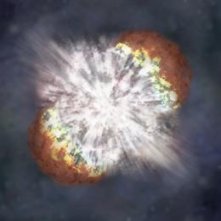Massive supernova produced rainbow of elements for months.

Astronomers have watched the violent death of what was probably the most massive star ever detected. The supernova explosion, which lasted for months, is thought to have generated more than 50 Suns' worth (1032 kilograms) of different elements, which may one day go on to make new solar systems.
The explosion — dubbed SN2007bi — was spotted as part of a digital survey to hunt for supernovae at the Palomar Observatory near San Diego, California.
One supernova in particular was very unusual, recalls Avishay Gal-Yam, an astronomer at the Weizmann Institute of Science in Rehovot, Israel, a member of the survey team.
The blast was first seen on 6 April 2007, but unlike most supernovae, which fade over a matter of weeks, this one burned steadily for months. "It was very, very slow," says Gal-Yam. "I came back after a week, after two weeks, after a month and five months and it was still about the same brightness."
Follow-up observations with some of the world's most powerful telescopes — including the W. M. Keck Observatory atop Mauna Kea, Hawaii, and the Paranal Observatory in Chile — revealed a supernova unlike any other. This week in Nature, Gal-Yam and his colleagues report that the explosion was probably that of a supermassive star, at least two hundred times the mass of the Sun. The type of supernova that it produced — a ‘pair-instability' supernovae — had been predicted by theory, they say, but never observed.
The explosion generated several Suns' worth of radioactive nickel-56 and vast quantities of other lighter elements, such as carbon and silicon. Gal-Yam says that it is the radioactive decay of the nickel that kept the explosion glowing for months.
Stellar colossus
"This is definitely something we haven't seen before," Gal-Yam says. "There are no such stars seen in our galaxy or other nearby galaxies. It's a rather spectacular star."
Some astronomers have suggested that stars might not be able to grow larger than about 150 solar masses, in part because powerful solar winds might blow off any additional material. A survey of the stars in our own Milky Way galaxy seemed to support the idea of this stellar size limit (see ‘Stars can only grow so big').
Stars in the Milky Way are mostly made of the hydrogen and helium, with a few percent of their mass made up of heavier elements. But the Universe's most massive stars are thought to have much smaller proportions of heavy elements, allowing them to grow bigger and burn far brighter, before dying in a spectacular pair-instability supernova.
Photons generated within the star exert an outward pressure that keeps these giants from collapsing — at least until the star fades as it ages. Once the star contracts the temperature inside rises, making photons convert into pairs of electrons and positrons (the anti-particles of electrons). These new particles don't exert the same outward pressure on the star as their photon parents, and the result is a runaway collapse, followed by a massive explosion of the star's core.
Pair-instability supernovae have been predicted for decades, but none has been seen until now, says Norbert Langer, an astrophysicist at the University of Bonn in Germany.
In addition to providing confirmation of an old theory, the new supernova could provide insight into the early Universe. Astronomers think that the Universe was almost entirely composed of hydrogen and helium shortly after the Big Bang. Those elements are thought to have formed giant stars that burned briefly and brightly before exploding, creating heavier elements that eventually went on to form planets and people. "There's a long interest in how these first stars evolved and died," Langer says. This star's death could provide some clues.
It has also raised some questions, Langer adds. In particular, the supernova seemed to contain no hydrogen. Given that light elements are thought to be important in such a star, it is "a strange thing" that the hydrogen is not there, says Langer. Gal-Yam agrees: "We should have detected it rather easily," he says. "I think it was removed, very efficiently, by some [unknown] mechanism."
